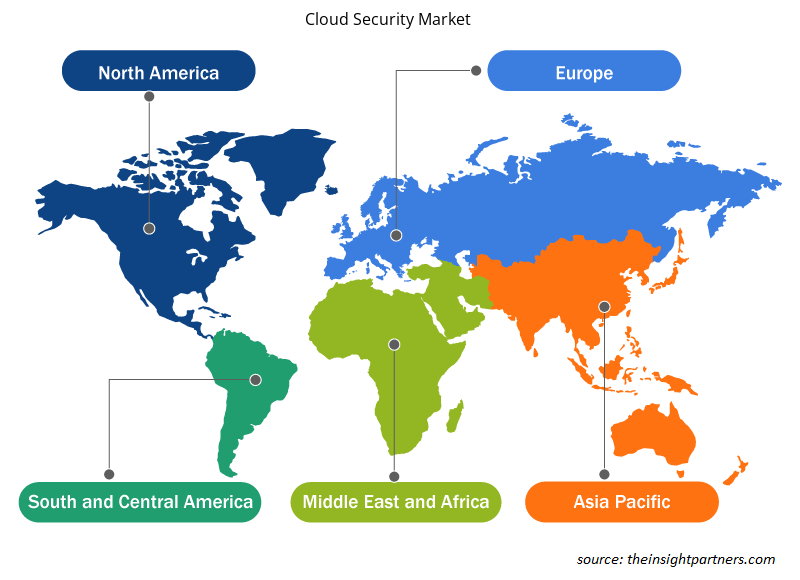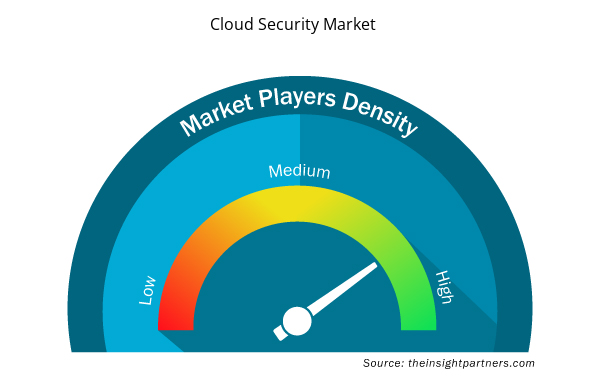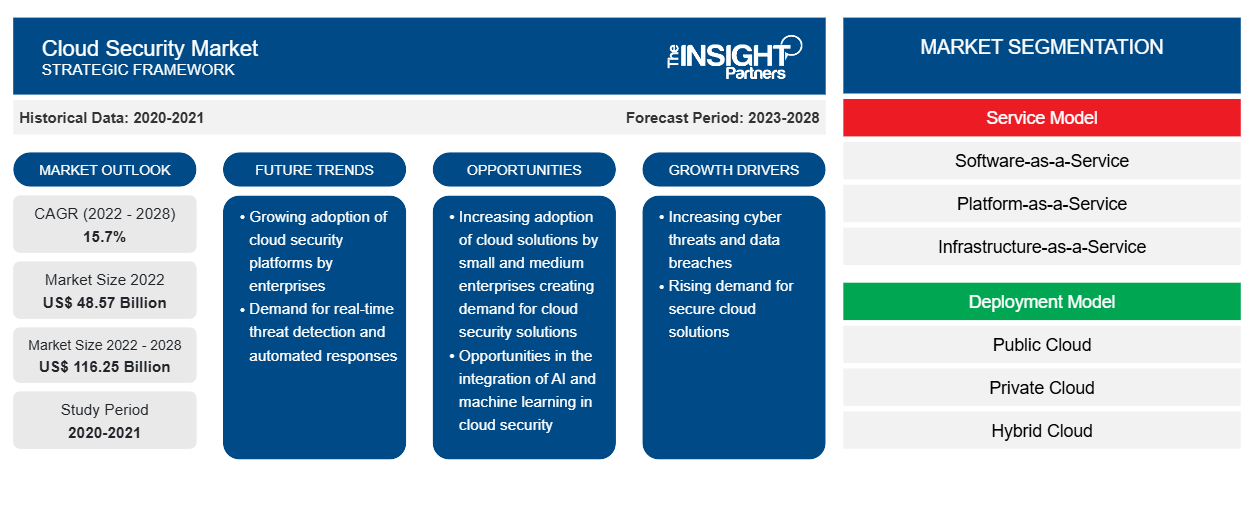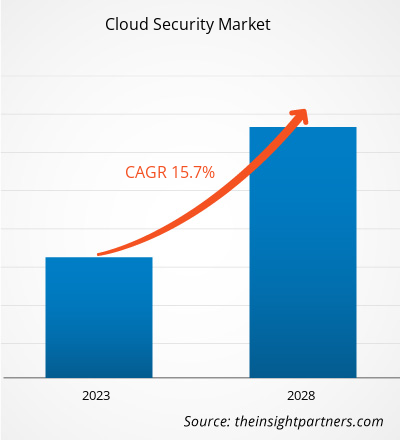Se espera que el mercado de seguridad en la nube crezca de US$ 48,57 mil millones en 2022 a US$ 116,25 mil millones en 2028; se estima que crecerá a una CAGR del 15,7% entre 2022 y 2028.
El mantenimiento de la seguridad se ha vuelto crucial en las empresas debido al creciente número de infracciones en línea y ataques tecnológicos. La seguridad en la nube proporciona numerosos niveles de protección dentro de la infraestructura de red contra accesos no autorizados, violaciones de datos y ataques distribuidos de denegación de servicio (DDoS). En 2022, Flexera, una empresa estadounidense de software informático, realizó un estudio y proyectó que casi el 57% de las organizaciones están trasladando sus cargas de trabajo a la nube. Además, casi 6 de cada 10 empresas trasladaron su trabajo a la nube. Por lo tanto, el creciente número de empresas que utilizan infraestructura basada en la nube está impulsando la adopción de soluciones de seguridad en la nube.
La presencia de grandes empresas reconocidas y financieramente sólidas en la industria global de seguridad en la nube incluye a Amazon Web Services, Inc.; Microsoft; IBM Corporation; Oracle; y Google, Inc.. Debido a esto, el poder de negociación de los compradores en el mercado de seguridad en la nube es bastante alto. Además, debido a los avances tecnológicos en seguridad en la nube y al aumento de los servicios de contenedores administrados, se estima que el poder de negociación de los compradores seguirá siendo alto durante 2019-2028. Las principales empresas del mercado de seguridad en la nube utilizan diferentes estrategias al planificar modelos de soluciones y servicios para diferentes verticales de la industria. Se anticipa que los avances continuos en el sector tecnológico presionarán a los proveedores de seguridad en la nube para que se adapten a los cambios para mantener su posición en el mercado.
Personalice este informe según sus necesidades
Obtendrá personalización en cualquier informe, sin cargo, incluidas partes de este informe o análisis a nivel de país, paquete de datos de Excel, así como también grandes ofertas y descuentos para empresas emergentes y universidades.
- Obtenga las principales tendencias clave del mercado de este informe.Esta muestra GRATUITA incluirá análisis de datos, desde tendencias del mercado hasta estimaciones y pronósticos.
Perspectivas regionales del mercado de seguridad en la nube
Los analistas de Insight Partners explicaron en detalle las tendencias y los factores regionales que influyen en el mercado de seguridad en la nube durante el período de pronóstico. Esta sección también analiza los segmentos y la geografía del mercado de seguridad en la nube en América del Norte, Europa, Asia Pacífico, Oriente Medio y África, y América del Sur y Central.

- Obtenga datos regionales específicos para el mercado de seguridad en la nube
Alcance del informe sobre el mercado de seguridad en la nube
| Atributo del informe | Detalles |
|---|---|
| Tamaño del mercado en 2022 | US$ 48,57 mil millones |
| Tamaño del mercado en 2028 | US$ 116,25 mil millones |
| CAGR global (2022-2028)CAGR (2022 - 2028) | 15,7% |
| Datos históricos | 2020-2021 |
| Período de pronóstico | 2023-2028 |
| Segmentos cubiertos | Por modelo de servicio
|
| Regiones y países cubiertos | América del norte
|
| Líderes del mercado y perfiles de empresas clave |
|
Densidad de actores del mercado: comprensión de su impacto en la dinámica empresarial
El mercado de seguridad en la nube está creciendo rápidamente, impulsado por la creciente demanda de los usuarios finales debido a factores como la evolución de las preferencias de los consumidores, los avances tecnológicos y una mayor conciencia de los beneficios del producto. A medida que aumenta la demanda, las empresas amplían sus ofertas, innovan para satisfacer las necesidades de los consumidores y aprovechan las tendencias emergentes, lo que impulsa aún más el crecimiento del mercado.
La densidad de actores del mercado se refiere a la distribución de las empresas o firmas que operan dentro de un mercado o industria en particular. Indica cuántos competidores (actores del mercado) están presentes en un espacio de mercado determinado en relación con su tamaño o valor total de mercado.
Las principales empresas que operan en el mercado de seguridad en la nube son:
- Servicios web de Amazon, Inc.
- Microsoft
- Google LLC
- Oráculo
- Corporación IBM
Descargo de responsabilidad : Las empresas enumeradas anteriormente no están clasificadas en ningún orden particular.

- Obtenga una descripción general de los principales actores clave del mercado de seguridad en la nube
El mercado de seguridad en la nube está segmentado en cinco regiones principales: América del Norte, Europa, Asia Pacífico (APAC), Oriente Medio y África, y América del Sur. En 2022, América del Norte lideró el mercado con una participación sustancial en los ingresos, seguida de Europa. Además, se espera que Asia Pacífico registre la CAGR más alta del mercado entre 2022 y 2028.
Amazon Web Services, Inc.; Microsoft; IBM Corporation; Oracle; Trend Micro Incorporated; VMware, Inc.; Palo Alto Networks, Inc.; Cisco Systems, Inc.; Check Point Software Technologies Ltd.; y Google, Inc. se encuentran entre los actores clave que operan en el mercado de seguridad en la nube. El informe de mercado proporciona información detallada del mercado, que ayuda a los actores clave a diseñar estrategias de crecimiento para los próximos años.
- Análisis histórico (2 años), año base, pronóstico (7 años) con CAGR
- Análisis PEST y FODA
- Tamaño del mercado Valor/volumen: global, regional, nacional
- Industria y panorama competitivo
- Conjunto de datos de Excel


- Adaptive Traffic Control System Market
- Pressure Vessel Composite Materials Market
- Carbon Fiber Market
- Personality Assessment Solution Market
- Portable Power Station Market
- Aerospace Forging Market
- Hot Melt Adhesives Market
- Micro-Surgical Robot Market
- Online Exam Proctoring Market
- Emergency Department Information System (EDIS) Market

Report Coverage
Revenue forecast, Company Analysis, Industry landscape, Growth factors, and Trends

Segment Covered
This text is related
to segments covered.

Regional Scope
North America, Europe, Asia Pacific, Middle East & Africa, South & Central America

Country Scope
This text is related
to country scope.
Preguntas frecuentes
Amazon Web Services, Inc.; Microsoft; IBM Corporation; Oracle; Trend Micro Incorporated; VMware, Inc.; Palo Alto Networks, Inc.; Cisco Systems, Inc.; Check Point Software Technologies Ltd.; and Google, Inc. are the leading companies in the cloud security market.
Cloud-native applications, which are created specifically to operate on the cloud, are gaining prevalence with the growing use of cloud platforms; therefore—surge in technological advancements in cloud security is one of the major trends in the cloud security market.
North America dominated the cloud security market in 2021. With higher penetration of large and mid-sized companies, there is a growing frequency of cyber-attacks and the increasing number of hosted servers. Moreover, growing number of cybercrime and the production of new cyberattacks, as well as surge in usage of cloud-based solutions are all becoming major factor propelling the market growth in the region.
With growing adoption of artificial intelligence & machine learning, cybersecurity teams are expected to gain valuable tools for averting security breaches and focusing more on innovation to achieve their long-term business goals. Also, surge in number of governments initiatives & investments in cloud technology are anticipated to create growth opportunity for the market players in the coming years.
Due to rising number of cyberattacks, businesses are implementing cutting-edge cybersecurity tools to identify risks and reduce costs associated with data breaches. Moreover, surge in usage of cloud-based solutions & managed security services and increasing managed container services are propelling the growth of the cloud security market.
Trends and growth analysis reports related to Technology, Media and Telecommunications : READ MORE..
The List of Companies - Cloud Security Market
- Amazon Web Services, Inc.
- Microsoft
- Google LLC
- Oracle
- IBM Corporation
- Cisco System, Inc.
- Trend Micro Incorporated
- Palo Alto Networks, Inc.
- Checkpoint Software Technologies
- VMware, Inc.
The Insight Partners performs research in 4 major stages: Data Collection & Secondary Research, Primary Research, Data Analysis and Data Triangulation & Final Review.
- Data Collection and Secondary Research:
As a market research and consulting firm operating from a decade, we have published and advised several client across the globe. First step for any study will start with an assessment of currently available data and insights from existing reports. Further, historical and current market information is collected from Investor Presentations, Annual Reports, SEC Filings, etc., and other information related to company’s performance and market positioning are gathered from Paid Databases (Factiva, Hoovers, and Reuters) and various other publications available in public domain.
Several associations trade associates, technical forums, institutes, societies and organization are accessed to gain technical as well as market related insights through their publications such as research papers, blogs and press releases related to the studies are referred to get cues about the market. Further, white papers, journals, magazines, and other news articles published in last 3 years are scrutinized and analyzed to understand the current market trends.
- Primary Research:
The primarily interview analysis comprise of data obtained from industry participants interview and answers to survey questions gathered by in-house primary team.
For primary research, interviews are conducted with industry experts/CEOs/Marketing Managers/VPs/Subject Matter Experts from both demand and supply side to get a 360-degree view of the market. The primary team conducts several interviews based on the complexity of the markets to understand the various market trends and dynamics which makes research more credible and precise.
A typical research interview fulfils the following functions:
- Provides first-hand information on the market size, market trends, growth trends, competitive landscape, and outlook
- Validates and strengthens in-house secondary research findings
- Develops the analysis team’s expertise and market understanding
Primary research involves email interactions and telephone interviews for each market, category, segment, and sub-segment across geographies. The participants who typically take part in such a process include, but are not limited to:
- Industry participants: VPs, business development managers, market intelligence managers and national sales managers
- Outside experts: Valuation experts, research analysts and key opinion leaders specializing in the electronics and semiconductor industry.
Below is the breakup of our primary respondents by company, designation, and region:

Once we receive the confirmation from primary research sources or primary respondents, we finalize the base year market estimation and forecast the data as per the macroeconomic and microeconomic factors assessed during data collection.
- Data Analysis:
Once data is validated through both secondary as well as primary respondents, we finalize the market estimations by hypothesis formulation and factor analysis at regional and country level.
- Macro-Economic Factor Analysis:
We analyse macroeconomic indicators such the gross domestic product (GDP), increase in the demand for goods and services across industries, technological advancement, regional economic growth, governmental policies, the influence of COVID-19, PEST analysis, and other aspects. This analysis aids in setting benchmarks for various nations/regions and approximating market splits. Additionally, the general trend of the aforementioned components aid in determining the market's development possibilities.
- Country Level Data:
Various factors that are especially aligned to the country are taken into account to determine the market size for a certain area and country, including the presence of vendors, such as headquarters and offices, the country's GDP, demand patterns, and industry growth. To comprehend the market dynamics for the nation, a number of growth variables, inhibitors, application areas, and current market trends are researched. The aforementioned elements aid in determining the country's overall market's growth potential.
- Company Profile:
The “Table of Contents” is formulated by listing and analyzing more than 25 - 30 companies operating in the market ecosystem across geographies. However, we profile only 10 companies as a standard practice in our syndicate reports. These 10 companies comprise leading, emerging, and regional players. Nonetheless, our analysis is not restricted to the 10 listed companies, we also analyze other companies present in the market to develop a holistic view and understand the prevailing trends. The “Company Profiles” section in the report covers key facts, business description, products & services, financial information, SWOT analysis, and key developments. The financial information presented is extracted from the annual reports and official documents of the publicly listed companies. Upon collecting the information for the sections of respective companies, we verify them via various primary sources and then compile the data in respective company profiles. The company level information helps us in deriving the base number as well as in forecasting the market size.
- Developing Base Number:
Aggregation of sales statistics (2020-2022) and macro-economic factor, and other secondary and primary research insights are utilized to arrive at base number and related market shares for 2022. The data gaps are identified in this step and relevant market data is analyzed, collected from paid primary interviews or databases. On finalizing the base year market size, forecasts are developed on the basis of macro-economic, industry and market growth factors and company level analysis.
- Data Triangulation and Final Review:
The market findings and base year market size calculations are validated from supply as well as demand side. Demand side validations are based on macro-economic factor analysis and benchmarks for respective regions and countries. In case of supply side validations, revenues of major companies are estimated (in case not available) based on industry benchmark, approximate number of employees, product portfolio, and primary interviews revenues are gathered. Further revenue from target product/service segment is assessed to avoid overshooting of market statistics. In case of heavy deviations between supply and demand side values, all thes steps are repeated to achieve synchronization.
We follow an iterative model, wherein we share our research findings with Subject Matter Experts (SME’s) and Key Opinion Leaders (KOLs) until consensus view of the market is not formulated – this model negates any drastic deviation in the opinions of experts. Only validated and universally acceptable research findings are quoted in our reports.
We have important check points that we use to validate our research findings – which we call – data triangulation, where we validate the information, we generate from secondary sources with primary interviews and then we re-validate with our internal data bases and Subject matter experts. This comprehensive model enables us to deliver high quality, reliable data in shortest possible time.


 Obtenga una muestra gratuita de este informe
Obtenga una muestra gratuita de este informe